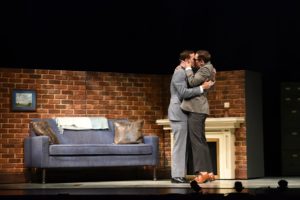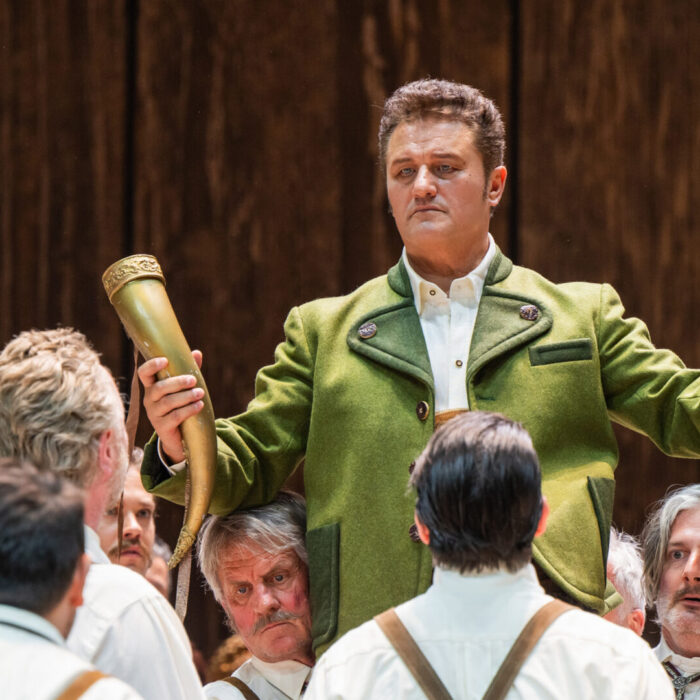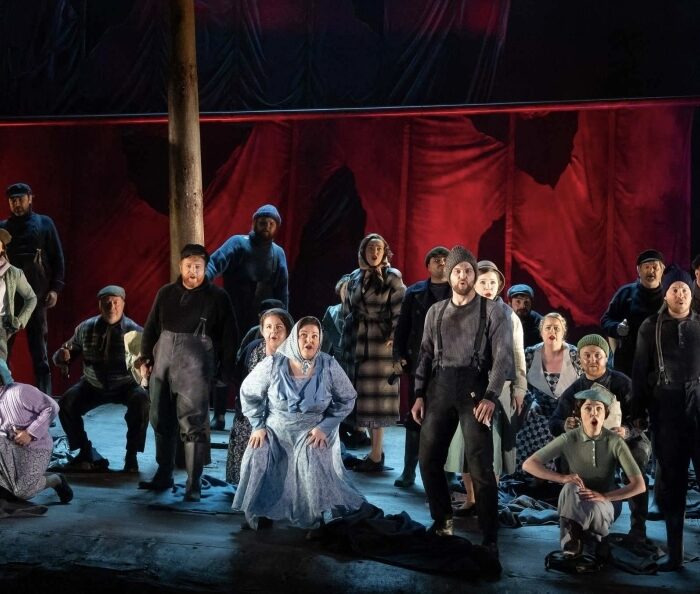
Arizona Opera 2019-20 Review: Fellow Travelers
LGBT Opera Shows the Hypocrisy of the Fifties & Love in Dangerous Times
By Maria Nockin(Credit: Tim Trumble Photography)
On Nov. 8, 2019, the Arizona Opera presented composer Gregory Spears and librettist Greg Pierce’s 2016 opera “Fellow Travelers.” The opera, which premiered at the Cincinnati Opera, has quickly grown in popularity having been presented at the Lyric Opera of Chicago in March 2018, and at the Minnesota Opera three months later. That is not a surprise to anyone who has heard its enchantingly original music. Yes, it has its Puccini-style moments, but it also relates to much earlier music and contains tonal vocal harmony rarely heard in 21st century opera. Spears’ music shows human grace and warmth one moment and counteracts it with chilling dissonance the next. Thus, he magnifies and intensifies the conflict between characters.
The Opera
Spears’ writing for duets and ensembles is especially fascinating because he knows where the most resonant notes are in each voice type. Two or more voices often sing against sustained chords which allow the vocal tone to surge over the auditorium. What a joy it is to listen to the work of a composer who makes a point of knowing how to write for the voice. The exquisite vocal interaction of his Act two quartet is just one example of this composer’s ability with ensembles.
This, however, is not to say Spears’ music is in any way lacking in orchestral weight. His orchestration is unusual and he presents unexpected but tonal harmony colored by pastel dissonances that don’t disturb ears accustomed to traditional classical music.
Greg Pierce based his libretto on Thomas Mallon’s 2007 novel “Fellow Travelers” and takes place in the 1950s when gay men and women in government were targeted with the same vehemence as communists because it was presumed that that their private behavior could open them to blackmail. Mallon’s story and Pierce’s libretto tell of a love affair between State Department official Hawkins Fuller and aspiring journalist Timothy Laughlin.
Although today’s society realizes that these men deserved a life in open togetherness, in the 1950s such a relationship was not accepted. As a result, each man suffered an irreparable loss.
The Production
The production, originally conceived by Kevin Newbury, was directed in Arizona by Marcus Shields and he helped the singers develop the complex, multi-dimensional characterizations that propelled the story inevitably toward its tragic end. At the start two men meet sitting on the same park bench, and they part years later after a final meeting on that same bench. Nothing could be simpler, except for the complexity of human emotional involvement that is showcased throughout the work.
Scenic Designer Victoria “Vita” Tzykun gave audiences an unadorned bench where the park had to be imagined but which also brought the relationship to the forefront and created greater intimacy. For 14 other scenes she supplied rolling files, beds, tables, chairs, flags, a fireplace, and Christmas decor. Each combination made each scene come to life while Paul Carey’s costume concepts, as translated by coordinator Kathleen Trott, established the time period with bright colors and full, crinoline underscored skirts for the women. The men wore traditional dark suits and hats. Thomas Hase’s lighting design focused the audience’s attention where it needed to be emphasizing the central characters and their emotions.

Credit: Tim Trumble Photography
A Dynamic Cast
As Timothy Laughlin, charismatic tenor Jonas Hacker had the longest and most difficult part. Although conductor Daniela Candillari never covered his sound, he sang a great many well-focused forte and fortissimo high notes. His character gradually grew from a nervous youth to a young man who could stand on his own before important government officials. Both his acting and his vocal coloring told of his character’s innate vulnerability.
Baritone Joseph Lattanzi was his lover “Hawk.” Both he and Laughlin reunited after having performed these roles in 2018 at the Lyric Opera of Chicago and together again in Arizona, they had intense dramatic chemistry as well as a truly beautiful vocal blend.
Lattanzi developed the character with nuance. At first he was simply looking for a pliable young lover. With Timothy, he got that and affection that could have lasted a lifetime had society allowed it. When he realized the depth of Timothy’s love, Hawk, who married a young woman for appearances sake, turned his lover away by outing him.
Katherine Beck was a well-grounded Mary and her sizable dramatic voice handled coloratura with difficulty. Marcus DeLoach was a raucous, blustering, but credible Senator McCarthy, an amusing Estonian, and an evil-intentioned interrogator. Kaitlyn Johnson was a smart-looking, gossiping Miss Lightfoot, and Rob McGinness was an arrogant, energetic Tommy McIntyre. Cadie Jordan was a credibly naive bride who had no idea of what was in store for her as a married woman. Leaning on two canes, baritone Thomas Cannon assumed the role of the handicapped Senator Potter. Cannon and bass-baritone Brandon Morales portrayed multiple roles that showed the ability of each to create a realistic character with a few lines.
Conductor Daniela Candillari led 17 top-level members of the Arizona Opera Orchestra in a translucent but multicolored and textured rendition of Spears’ entrancing score. The clarinet and flute solos contained the music I would most like to hear again.
Overall this is an opera to experience and one that deserves multiple viewings. It’s too good to be allowed to disappear into the ether.


